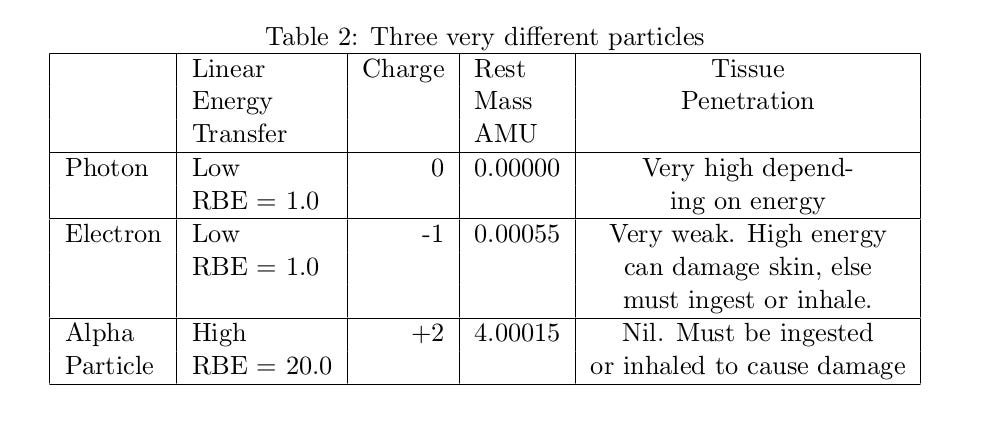Is Devanney an anti-nuke mole?
This post requires a little background in radiation protection. First timers, should read LNT is nonsense. Grays(Gy) are just the amount of radiation energy in joules deposited in a kg of tissue. Sieverts(Sv) are just grays multiplied by a bugger factor, called RBE, that attempts to account for the fact that some types of radiation produce worse damage per gray than others. That bugger factor is 1.0 for photons and electrons; 20.0 for alpha particles.
A properly referenced PDF of this post is attached at the bottom.
Despite my pronouncement that my blatherings are infallible, there will always be doubters such as Geoff Russell. Russell is an Australian polymath and author, who spends most of his time explaining why we should not eat dumb animals, although he might make an exception for certain Ozzie politicians. His blog stuffthatcounts is highly recommended.
In The Case of 1 mSv per day and again in Why are we so good at repairing radiation damage, I claimed that it would take 250 millisieverts per day to create the same number of DNA Double Strand Breaks as are produced endogenously by our oxygen based metabolism. Russell wants to know where the 250 mSv/day number came from. He points out that Vilenchik and Knudson, two guys who actually know something about DNA damage and repair, having spent their whole life studying it, come up with 1500 to 2000 mSv per day.\cite{vilenchik-2003} Implicit in his question is the dark suggestion that my long career in fossil fuel may not really be over.
Table 1 shows some estimates of the number of Single Strand Breaks(SSB's) and Double Strand Breaks(DSB's) each of our cells endure per day from normal metabolism. Double strand breaks represent almost all the damage that leads to cancer, since essentially error-free repair cannot be guaranteed.
Radioactive decay produces three very different particles: photons, electrons, and alpha particles, Table 2. Electrons and alpha particles are charged particles; photons have no charge. Electrons and alphas interact with the electromagnetic fields within our tissue. They have little to no penetrating power. Photons do not and are highly penetrating. This difference is the key to understanding the nuclear waste problem.
Alpha particle damage is highly localized, clumped along the heavy particle's short, straight track. This is called high LET (Linear Energy Transfer) damage. Clumped damage is much more likely to create DSB's from the same amount of energy. Photon and electron damage, low LET, is far more spread out, much more like endogenous damage. In a nuclear power plant casualty, there is usually nil release of alpha particles; and, when it happens as it did at Chernobyl, the heavy alphas fall out very close to the plant. Alphas must be ingested or inhaled to do any damage. Almost all the radiation damage to the public in a nuclear plant release is low LET.
Table 3 shows some estimates of the rate at which low LET radiation produces DSB's. Alpha particles produce very roughly 20 times more DSB's per milligray, so we multiply alpha particle energy by a factor of 20 in converting grays to sieverts, while the conversion factor for low LET radiation is 1.0. Then we can use the same table for both with the right column relabeled DSB/mSv.
There's a factor of 5 range in both the estimates of endogenous DSB production and the estimates of radiation induced DSB. This uncertainty is understandable. When the two numbers are ratioed to determine the dose rate which creates the same number of DSB's as endogenous damage, you end up with a factor of 25 range, 200 mSv/day to 5000 mSv/day, from low end endogenous compared with high end radiation to high end endogenous compared with low end radiation.
Vilenchik and Knudsen based their best guess equivalence number on 0.03 DSB/mSv and 45 endogenous DSB/cell-day to come up with 1500 mSv/day. Devanney, reflecting his anti-nuke bias, used 0.04 DSB/mSv (high) and 10 endogenous (low) to come up with 250 mSv/day. Take your pick. Do you go with
(a). two guys who have spent their whole life studying DNA repair, or
(b). an oil tanker operator with a strong background in corrosion control (aka rust)?
Russell chose (a); but he's a vegan who walks upside down. I trust the choir will make a wiser choice, lest the wrath of OPEC descend upon them.
Seriously, if Vilenchik and Knudsen are right, the 1 mSv/d should probably be adjusted upward. Overly conservative limits are as harmful as overly aggressive.






Hey Jack, I had an idea for an extra source of post inspiration. I have heard a podcast episode interviewing you (I think on Decouple) which I though was great.
At some point I may go searching for other podcast appearances and this made me think that if there are a number of them you could write posts featuring them and riffing on the core points or expanding on something that got missed
I sense a certain amount of insider humour in this post Jack. Surely anyone suggesting 250 millisieverts per day is just hunky dory could simply not be construed as being an anti-nuke. Especially so when most anti-nukes suggest that via the yet-unproven LNT hypothesis, even a single photon emission is a flat no-no. I'd be willing to bet that Geoff would allow that 2 Sv/day might be a titch risky.